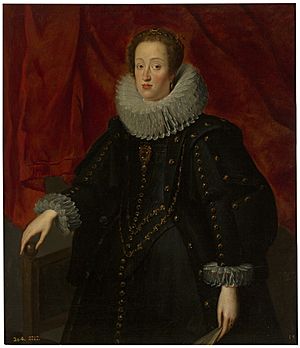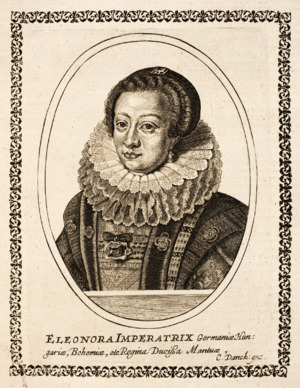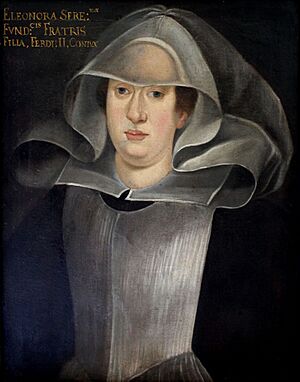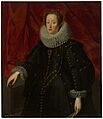Eleonora Gonzaga (1598–1655) facts for kids
Quick facts for kids Eleonora Gonzaga |
|
|---|---|
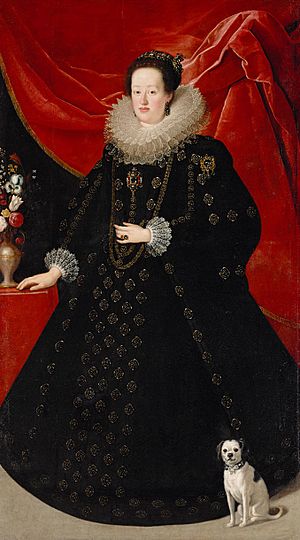
|
|
| Holy Roman Empress | |
| Tenure | 2 February 1622 – 15 February 1637 |
| Coronation | 7 November 1627 |
| Born | 23 September 1598 Mantua, Duchy of Mantua |
| Died | 27 June 1655 (aged 56) Vienna, Archduchy of Austria |
| Spouse | Ferdinand II, Holy Roman Emperor |
| House | Gonzaga |
| Father | Vincenzo Gonzaga, Duke of Mantua |
| Mother | Eleonora de' Medici |
Eleonora Gonzaga (born September 23, 1598 – died June 27, 1655) was a princess from the House of Gonzaga in Mantua. She became the Holy Roman Empress, German Queen, and Queen of Hungary and Bohemia when she married Ferdinand II, Holy Roman Emperor.
People called her the Elder (German: Ältere) to tell her apart from her great-niece, who had the same name. As Empress, she helped make the Imperial court in Vienna a famous place for Baroque music. She also strongly supported the Counter-Reformation, a movement to strengthen the Catholic Church.
Contents
Eleonora's Life Story
Her Childhood in Mantua
Eleonora was born in Mantua on September 23, 1598. She was the youngest child of Vincenzo Gonzaga, Duke of Mantua and Monferrato, and his wife Eleonora de' Medici. Her family was very important in Europe.
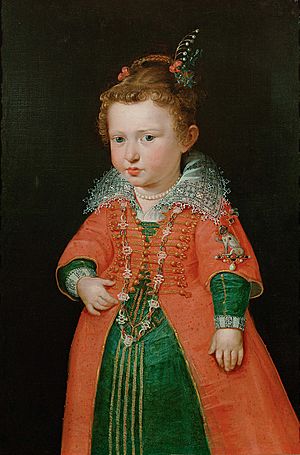
When she was two months old, Eleonora was baptized with the names Eleonora Anna Maria. This honored her mother and two older sisters. Her godparents included Ferdinand III, Archduke of Inner Austria, who would later become her husband.

Eleonora grew up in the ducal court in Mantua. This court was a center for European culture and science. When she was ten, her aunt, Margherita Gonzaga, took charge of her education. Her aunt made sure Eleonora learned foreign languages, history, music, and painting. Eleonora grew up in a very religious environment. This influenced her to be very pious and charitable.
When Eleonora was 12, her father tried to arrange a marriage for her. First, he considered a marriage to Marcantonio IV Colonna, a Duke and Prince. Then, he thought about Victor Amadeus, the Prince of Piedmont. However, neither of these marriages happened. Her father died in 1612 before he could arrange her marriage.
Her Marriage to the Emperor
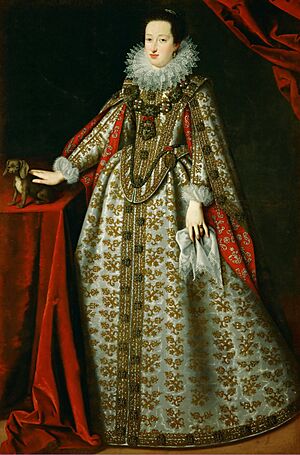
In 1621, Ferdinand II, Holy Roman Emperor, who was a widower, wanted to marry Eleonora. He sent his advisor to Mantua to arrange the marriage. The Pope gave special permission for the marriage because Ferdinand was Eleonora's relative and also her godfather. On November 21, 1621, the marriage contract was signed. The wedding ceremony took place in Innsbruck on February 2, 1622. It was a modest celebration.
As a wedding gift, Ferdinand gave Eleonora a beautiful jewel made of diamonds and pearls. Two days after the wedding, Eleonora's relatives returned to Mantua. The Imperial couple then traveled to Vienna.
Even though Eleonora and Ferdinand II had a big age difference, they had a happy marriage. They did not have any children together. However, Eleonora became very close to her stepchildren, especially Archduke Leopold Wilhelm. She helped him develop a love for art and books.
Like her husband, Eleonora was very religious. She strongly supported the Counter-Reformation. She gave money to churches and monasteries and cared a lot about charity. The Emperor and Empress both had Jesuit priests as their confessors. Eleonora and Ferdinand also enjoyed hunting and music together.
Holy Roman Empress and German Queen
When Eleonora arrived in Vienna, she quickly learned the German language. She kept the servants who had worked for the previous Empress. She sent most of her own servants back to Mantua. Ferdinand II gave his wife the Favorita palace. Later, she also received the Laxenburg and Schönbrunn palaces.
Eleonora was crowned Queen of Hungary in Pressburg on July 26, 1622. On November 7, 1627, she was crowned Holy Roman Empress and German Queen in Regensburg Cathedral. She was also crowned Queen of Bohemia in Prague on November 21 of that year.
Eleonora was not very interested in politics. However, she tried to be a good Empress for her people. She often went with her husband to meetings with other leaders. One of her important contributions was building the chapel of the Madonna of Loreto in the Augustinian Church. This chapel became the second one used by the Imperial court. Behind it, the Herzgruft was built. This place later held the hearts of members of the House of Habsburg.
With the Pope's approval, the Empress built a monastery for Discalced Carmelites in Vienna. She left money in her will for prayers for her soul. She and her husband also founded another Carmelite monastery in Vienna. The Empress supported a group that buried homeless people. She also helped the Carmelites in Graz.
Eleonora also supported Italian artists who came to her court. She helped Italian musicians and dancers. Because of her, the Imperial court in Vienna became a major center for European baroque music. She started the tradition of attending opera and ballet shows during special family celebrations. The first show was for Ferdinand II's birthday in 1625. For this, a large wooden hall was built at the Hofburg palace.
A big worry for Eleonora was the War of the Mantuan Succession (1628–1631). This war started after her brothers died without sons. During this war, the Imperial army captured and looted Mantua, her homeland.
Widowhood and Later Years
Emperor Ferdinand II died on February 15, 1637. After his death, Eleonora, now a widow, moved to Graz Castle. This was near her husband's tomb. Later that year, she moved to Vienna. She lived in the Discalced Carmelite monastery that she had founded. People at the time said she lived a very religious life. She also spent time in her palaces outside the city, like Schönbrunn. She had Schönbrunn designed in the Italian Baroque style.
In 1637, the amount of money she would receive as Dowager Empress was decided. The jewelry she received from her husband, including her wedding gift, was returned to the Habsburg family treasury.
The Dowager Empress continued to write letters to her Italian and Austrian relatives. She helped arrange the marriage between her grandniece, Eleonora, and her stepson, Emperor Ferdinand III. This marriage contract was signed in 1651.
In her will, written in 1651, Eleonora named her grandniece, Empress Eleonora, as her main heir. She also left a lot of money for memorial services and charity. Eleonora, the Dowager Empress, died in Vienna on June 27, 1655, at age 56. She was buried in the Discalced Carmelite monastery. Her heart was placed in a special container next to her husband's tomb. In 1782, her remains were moved to St. Stephen's Cathedral in Vienna.
Images for kids
-
Eleonora as a child, around 1600/01, probably by Peter Paul Rubens. Kunsthistorisches Museum, Vienna.
-
Eleonora as a child, by Frans Pourbus the Younger, around 1605. Palazzo Pitti, Florence.
-
Eleonora in her wedding dress, by Justus Sustermans, 1621/22. Kunsthistorisches Museum, Vienna.
See also
 In Spanish: Leonor Gonzaga para niños
In Spanish: Leonor Gonzaga para niños


